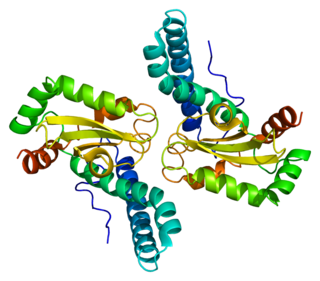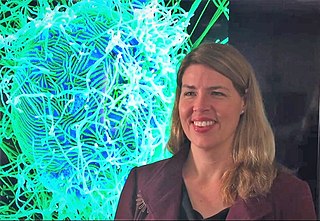Related Research Articles

Superoxide dismutase (SOD, EC 1.15.1.1) is an enzyme that alternately catalyzes the dismutation (or partitioning) of the superoxide (O−
2) radical into ordinary molecular oxygen (O2) and hydrogen peroxide (H
2O
2). Superoxide is produced as a by-product of oxygen metabolism and, if not regulated, causes many types of cell damage. Hydrogen peroxide is also damaging and is degraded by other enzymes such as catalase. Thus, SOD is an important antioxidant defense in nearly all living cells exposed to oxygen. One exception is Lactobacillus plantarum and related lactobacilli, which use a different mechanism to prevent damage from reactive O−
2.

Metalloprotein is a generic term for a protein that contains a metal ion cofactor. A large proportion of all proteins are part of this category. For instance, at least 1000 human proteins contain zinc-binding protein domains although there may be up to 3000 human zinc metalloproteins.

Scripps Research, previously known as The Scripps Research Institute (TSRI), is a nonprofit American medical research facility that focuses on research and education in the biomedical sciences. Headquartered in San Diego, California, the institute has over 170 laboratories employing 2,100 scientists, technicians, graduate students, and administrative and other staff, making it the largest private, non-profit biomedical research organization in the United States and among the largest in the world.
Ian Andrew Wilson is the Hansen Professor of Structural Biology and chair of the Department of Integrative Structural and Computational Biology at the Scripps Research Institute in San Diego, California, United States.

Jane Shelby Richardson is an American biophysicist best known for developing the Richardson diagram, or ribbon diagram, a method of representing the 3D structure of proteins. Ribbon diagrams have become a standard representation of protein structures that has facilitated further investigation of protein structure and function globally. With interests in astronomy, math, physics, botany, and philosophy, Richardson took an unconventional route to establishing a science career. Today Richardson is a professor in biochemistry at Duke University.

Superoxide dismutase [Cu-Zn] also known as superoxide dismutase 1 or hSod1 is an enzyme that in humans is encoded by the SOD1 gene, located on chromosome 21. SOD1 is one of three human superoxide dismutases. It is implicated in apoptosis, familial amyotrophic lateral sclerosis and Parkinson's disease.

Superoxide dismutase 2, mitochondrial (SOD2), also known as manganese-dependent superoxide dismutase (MnSOD), is an enzyme which in humans is encoded by the SOD2 gene on chromosome 6. A related pseudogene has been identified on chromosome 1. Alternative splicing of this gene results in multiple transcript variants. This gene is a member of the iron/manganese superoxide dismutase family. It encodes a mitochondrial protein that forms a homotetramer and binds one manganese ion per subunit. This protein binds to the superoxide byproducts of oxidative phosphorylation and converts them to hydrogen peroxide and diatomic oxygen. Mutations in this gene have been associated with idiopathic cardiomyopathy (IDC), premature aging, sporadic motor neuron disease, and cancer.

Irwin Fridovich was an American biochemist who, together with his graduate student Joe M. McCord, discovered the enzymatic activity of copper-zinc superoxide dismutase (SOD),—to protect organisms from the toxic effects of superoxide free radicals formed as a byproduct of normal oxygen metabolism. Subsequently, Fridovich's research group also discovered the manganese-containing and the iron-containing SODs from Escherichia coli and the mitochondrial MnSOD (SOD2), now known to be an essential protein in mammals. He spent the rest of his career studying the biochemical mechanisms of SOD and of biological superoxide toxicity, using bacteria as model systems. Fridovich was also Professor Emeritus of Biochemistry at Duke University.
AutoDock is a molecular modeling simulation software. It is especially effective for protein-ligand docking. AutoDock 4 is available under the GNU General Public License. AutoDock is one of the most cited docking software applications in the research community. It is used by the FightAIDS@Home and OpenPandemics - COVID-19 projects run at World Community Grid, to search for antivirals against HIV/AIDS and COVID-19. In February 2007, a search of the ISI Citation Index showed more than 1,100 publications had been cited using the primary AutoDock method papers. As of 2009, this number surpassed 1,200.
Daved H. Fremont is a professor at the Washington University School of Medicine in St. Louis with dual appointments in the Departments of Pathology and Immunology/Biochemistry and Molecular Biophysics. He is currently director of the Computational and Molecular Biophysics Program. Fremont is also a principal investigator in the Center for Structural Genomics of Infectious Disease and his laboratory has deposited structures of proteins from several major human pathogens to the protein data bank (PDB).
The Asx turn is a structural feature in proteins and polypeptides. It consists of three amino acid residues in which residue i is an aspartate (Asp) or asparagine (Asn) that forms a hydrogen bond from its sidechain CO group to the mainchain NH group of residue i+2. About 14% of Asx residues present in proteins belong to Asx turns.

Nickel superoxide dismutase (Ni-SOD) is a metalloenzyme that, like the other superoxide dismutases, protects cells from oxidative damage by catalyzing the disproportionation of the cytotoxic superoxide radical to hydrogen peroxide and molecular oxygen. Superoxide is a reactive oxygen species that is produced in large amounts during photosynthesis and aerobic cellular respiration. The equation for the disproportionation of superoxide is shown below:
Nagasuma Chandra is an Indian structural biologist, biochemist and a professor at the department of biochemistry of the Indian Institute of Science. She is known for her studies on Mycobacterium tuberculosis. The Department of Biotechnology of the Government of India awarded her the National Bioscience Award for Career Development, one of the highest Indian science awards, for her contributions to biosciences in 2008.
Debasisa Mohanty is an Indian computational biologist, bioinformatician and a staff scientists at the National Institute of Immunology, India. Known for his studies on structure and function prediction of proteins, genome analysis and computer simulation of biomolecular systems, Mohanty is an elected fellow of all the three major Indian science academies namely the Indian Academy of Sciences, the Indian National Science Academy and the National Academy of Sciences, India. The Department of Biotechnology of the Government of India awarded him the National Bioscience Award for Career Development, one of the highest Indian science awards, for his contributions to biosciences, in 2009.

Carlos F. Barbas III was chair professor of the Janet and Keith Kellogg II and a chemist at the Scripps Research Institute. Barbas developed new therapies that can target HIV-1 and some kinds of cancer which went into clinical trials.

Helen Jane Dyson is a British-born biophysicist and a professor of integrative structural and computational biology at the Scripps Research Institute in La Jolla, California. She is also currently editor-in-chief of the Biophysical Journal. She was elected a member of the National Academy of Sciences in 2022.

Erica Ollmann Saphire is an American structural biologist and immunologist and a professor at the La Jolla Institute for Immunology. Her research investigates the structural biology of viruses that cause hemorrhagic fever such as Ebola, Sudan, Marburg, Bundibugyo, and Lassa. She was awarded the Presidential Early Career Award for Scientists and Engineers in 2008.
Türkan Haliloğlu is a Turkish biochemist researching biopolymers, computational structural biology, protein dynamics, binding and folding of proteins, and protein interactions. She is a professor in the department of chemical engineering and director of the polymer research center at the Boğaziçi University.
Katrina T. Forest is an American biologist who is the EB Fred Professor of Bacteriology and Chair in the Department of Bacteriology at the University of Wisconsin–Madison. Her research considers the use of structural biology to better understand pathogenesis. Forest is a Fellow of the American Society for Microbiology.

Nikolay V. Dokholyan is an American biophysicist, academic and researcher. He is a G. Thomas Passananti Professor and Vice Chair for Research at Penn State College of Medicine.
References
- ↑ "Getzoff, Elizabeth". vivo.scripps.edu. Retrieved 2020-03-07.
- ↑ "Skaggs Institute for Chemical Biology | Scripps Research". www.scripps.edu. Retrieved 2020-03-07.
- ↑ "ELIZABETH D. GETZOFF LABORATORY". www.scripps.edu. Retrieved 2020-03-07.
- ↑ pubmeddev. "Elizabeth D. Getzoff - PubMed - NCBI". www.ncbi.nlm.nih.gov. Retrieved 2020-03-07.
- 1 2 3 4 Google Scholar Author page, Accessed August 17, 2020